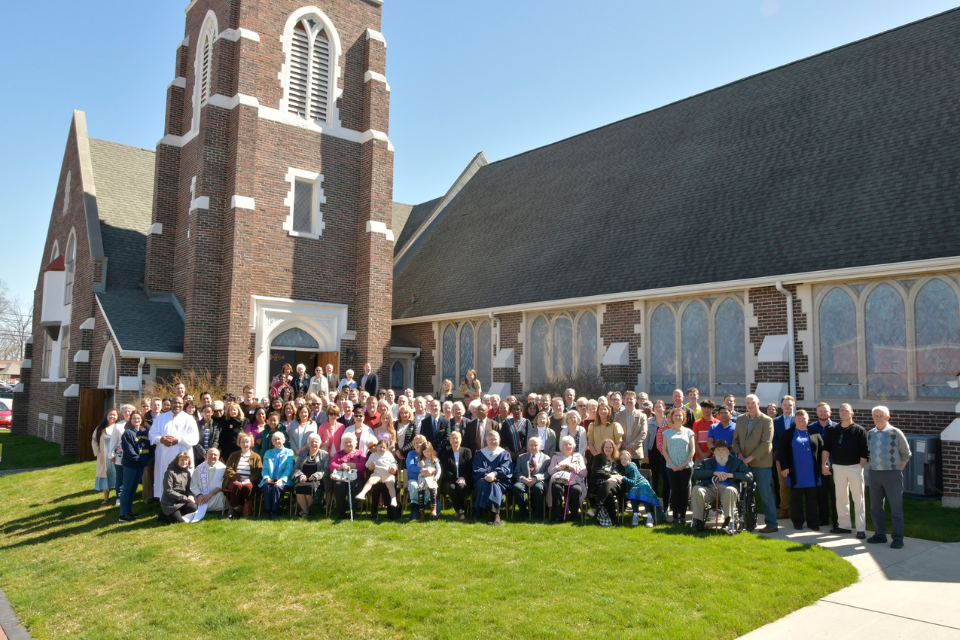Farmington: First UMC recently celebrated the centennial of their church building, and Bishop David Bard was the guest preacher.
The March 29, 1922, edition of The Michigan Christian Advocate reported that on March 19, Farmington dedicated its new church building. The publication noted, “Bishop Henderson, travel worn, but with natural force unabated, lifted the spirit of the day to true dedication heights.” When Farmington: First United Methodist Church celebrated the centennial of this same structure on April 7, 2024, their special guest, Bishop David Bard, exhibited no signs of travel weariness in delivering a spirited sermon titled “The Butterfly Effect” and joyfully interacting with church members.
The bishop reviewed how much this country’s cultural and religious landscape has changed over the past 100 years. To move forward in ministry, he encouraged the congregation to look to the future and consider how small acts of faithfulness can have significant long-term impact. He compared this to the meteorological theory that tiny changes in initial conditions can have a major impact, like the wings of a butterfly flapping in South America causing storms in Europe.
“When we do such things, when we embody the Spirit of Christ in small ways in the ordinary course of our lives, we give God the opportunity to multiply grace,” said Bishop Bard. “God’s Spirit is sometimes imagined as a butterfly. When we think of the butterfly effect in our ministry, it is trusting that our small acts of kindness, gentleness, and goodness allow the gentle winds from the wings of God’s Spirit to create remarkable ripple effects.”
During the celebration service, Rev. Dr. Anthony Hood, Farmington: First’s pastor, welcomed Bishop Bard and all current and former church members in attendance. Rev. Bea Fraser-Soots, associate pastor, had led the planning committee and oversaw logistics as the congregation moved from place to place following the service. Another planning committee member spoke on the building’s history, noting that Fred Warner, who attended the church with his wife and had served as Michigan’s governor from 1905 to 1911, had donated the distinctive stained glass window that dominates the wall behind the altar and choir loft. This striking window depicts four pioneers of Christian history: John the Baptist, John the Evangelist, the Apostle Paul, and John Wesley.
Immediately following the service, those in attendance gathered on the front lawn for a congregational photo, demonstrating their continued presence in their community. Farmington: First UMC faces Grand River Avenue in downtown Farmington, but the parking spaces and main entrance are located off the street behind the church, so those passing by on the street or sidewalks cannot see people entering and leaving the building for worship or other events.
Before the COVID-19 pandemic, Farmington: First hosted an ice cream and pie social during the annual Farmington Founders Festival for over forty years. Over three days, hundreds of festival attendees would seek relief from the heat and enjoy delicious servings of homemade pies and various ice cream creations in the church’s Wesley Hall. It was fitting then that, following the group photo shoot, the congregation gathered in Wesley Hall to enjoy a modified ice cream and pie social with the addition of sandwiches.
It was a festive atmosphere for the meal, and a few attendees took the microphone to share memories dating back to the 1950s. Planning committee members had posted photos in Wesley Hall and down hallways depicting the church building at various points over the past 100 years.
On the National Register of Historic Places, the church building was designed by architects Wells Butterfield and Emily Butterfield, his daughter, who was Michigan’s first licensed female architect. Their remarkable design placed the sanctuary and a community center/auditorium under the same roof. The community center included a stage and was, for many years, the largest meeting space and a center for civic life in the Farmington community. The center hosted movies, plays, concerts, graduation ceremonies, basketball games, and other community events. Some current members recall attending Sunday school classes in the community center space in the 1950s. Following World War II, the village of Farmington’s population multiplied, and the church’s congregation grew correspondingly. The community center was remodeled to incorporate pews; today, that section appears as the back section of the sanctuary.
Other significant additions responding to the growth in membership included the construction of an education wing in the 1950s and, more recently, between 2000 and 2002, the construction of a new wing for administrative offices and a main entrance to include an elevator. That project also included adding barrier-free bathrooms on each level and central air conditioning. Of course, the building has required ongoing maintenance. The HVAC and electrical systems have been updated in recent years, and the sanctuary ceiling has been replaced.
Again, excerpted from the March 29, 1922, issue of The Michigan Christian Advocate article: “The Farmington church cost lots of money and it is a beautiful church. Its quaint old English architecture, its beautiful lines, windows rich in color and design, and stately tower, combine in making a churchly church. . . . The church is built, and the dedication is over — now the work begins.”
One hundred years later, the work of the Farmington: First United Methodist congregation continues. As a concluding challenge, Bishop Bard said in his sermon, “Friends, you’ve come this far by faith, faith that is a trust that God can use our ordinary, everyday lives and our small acts to create significant change. . . . We’ve come this far by such faith, and the way forward is by such faith.”
Last Updated on June 18, 2024

